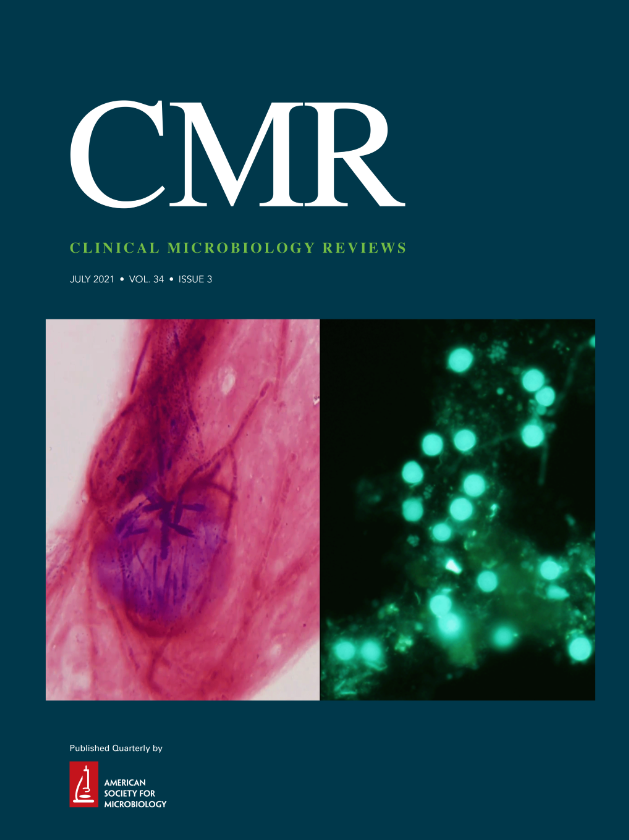Schistosomiasis: cercarial finding and recognizing of human hosts as a prerequisite of invasion.
IF 19.3
1区 医学
Q1 MICROBIOLOGY
引用次数: 0
Abstract
SUMMARYSchistosomiasis occurs in 80 primarily tropical and subtropical countries. It is transmitted to humans and animals by Schistosoma cercariae during freshwater contact. Parasite stages adapt and switch between molluscs, water, and mammals, where worms sustain parasitism. We reviewed research on larvae encountering humans published in PubMed, Embase, and Web of Science until May 2024. Larvae perform intermittent active/tail-first and passive/body-first swimming with arc-like re-encountering upon host approaches. Skin contacts occur spontaneously or through stimulants. Schistosoma mansoni, expressing chemokinesis, lingers in upper-middle warm clear water. Schistosoma haematobium, showing negative photo-orientation, remains in upper-lower, cooler, clear-muddy freshwater. Schistosoma japonicum stays stimuli-wise non-responsive in shallow muddy habitats. Attachment triggers of S. mansoni and S. haematobium are amino acids and temperature, respectively. S. japonicum adheres at random. Temperature gradient, ceramides, and acylglycerols stimulate the epidermal remaining of S. mansoni; solid hydrophobic surfaces trigger S. haematobium and S. japonicum. Temperatures of ≥36°C, ≥40°C, and 37°C guide S. mansoni, S. haematobium, and S. japonicum creeping for entering. Permeation aligns with schistosomula transformation by glycocalyx removal, heptalaminate membrane conversion, and tail stripping off and advances mechanically and enzymatically through acetabular glands. Skin and bloodstream navigation follows increasing L-arginine and D-glucose and parasite adjustment ventral-wards. Head gland enzymes facilitate epidermal-dermal transitioning for cutaneous exiting and vasculature accessing. Skin responds with anti-parasitic, anti-inflammatory edematous infiltrations. Schistosoma reacts by evasion through hormones, neurotransmitters, enzymes, and specialized proteins, among others. The findings, building largely on in vitro experiments, aim to facilitate the development of field-suitable prevention and control measures in support of the World Health Organization 2021-2030 Roadmap on Neglected Tropical Diseases.血吸虫病:发现和识别人类宿主作为入侵的先决条件。
血吸虫病主要发生在80个热带和亚热带国家。该病在淡水接触过程中通过尾蚴血吸虫传播给人类和动物。寄生虫阶段适应并在软体动物、水生动物和哺乳动物之间切换,其中蠕虫维持寄生。我们回顾了截至2024年5月在PubMed, Embase和Web of Science上发表的关于幼虫与人类接触的研究。幼虫进行间歇性的主动/尾巴优先和被动/身体优先的游泳,在宿主接近时进行弧形的再相遇。皮肤接触是自发或通过兴奋剂发生的。曼氏血吸虫表现趋化作用,在中上温清澈水中徘徊。血血吸虫呈负向光性,在上、下、冷、清浊的淡水中存活。日本血吸虫(Schistosoma japonicum)在浅泥泞的生境中保持对刺激的无反应。mansoni和haematobium的附着触发因子分别是氨基酸和温度。日本血吸虫随机附着。温度梯度、神经酰胺和酰基甘油刺激曼陀罗表皮残留;固体疏水性表面触发了血孢链球菌和日本血吸虫。温度≥36°C,≥40°C和37°C引导mansoni, S. haematobium和S. japonicum匍匐进入。渗透与血吸虫通过去除糖萼、七胺酸膜转化和尾部剥离的转化一致,并通过髋臼腺以机械和酶的方式推进。皮肤和血液导航随着l-精氨酸和d -葡萄糖的增加和腹侧寄生虫调节而增加。头腺酶促进表皮到真皮的过渡,使皮肤流出和血管进入。皮肤反应抗寄生虫,消炎水肿浸润。血吸虫的反应是通过激素、神经递质、酶和特殊蛋白质等进行逃避。这些发现主要建立在体外实验的基础上,旨在促进制定适合现场的预防和控制措施,以支持世界卫生组织《2021-2030年被忽视热带病路线图》。
本文章由计算机程序翻译,如有差异,请以英文原文为准。
求助全文
约1分钟内获得全文
求助全文
来源期刊

Clinical Microbiology Reviews
医学-微生物学
CiteScore
54.20
自引率
0.50%
发文量
38
期刊介绍:
Clinical Microbiology Reviews (CMR) is a journal that primarily focuses on clinical microbiology and immunology.It aims to provide readers with up-to-date information on the latest developments in these fields.CMR also presents the current state of knowledge in clinical microbiology and immunology.Additionally, the journal offers balanced and thought-provoking perspectives on controversial issues in these areas.
 求助内容:
求助内容: 应助结果提醒方式:
应助结果提醒方式:


